Aventon Level 3 ST Review | Step Through To A Sweet Ride!
The Level 3 ST is an accessible version of Aventon’s sporty, responsive, and high-tech long-range commuter.
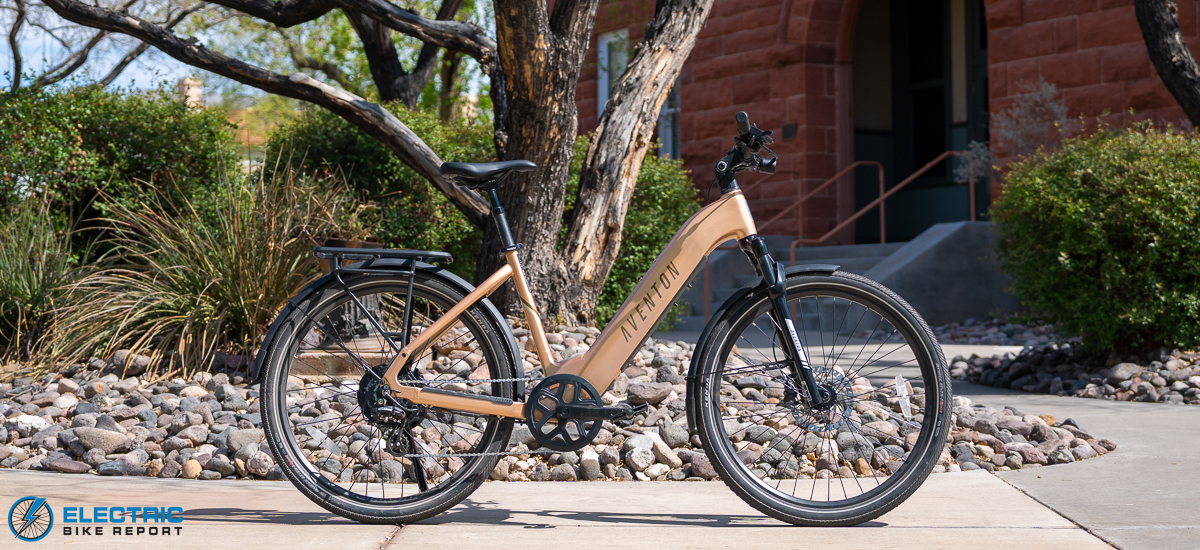
When you need a reliable method of getting to your daily destination, commuter e-bikes are the way to go. They’re typically well-equipped for all conditions with lights, fenders, and durable street tires. Most have high-capacity batteries to cover long round-trip rides. And many can reach swift Class 3 speeds to get you where you’re going post-haste.
Not all commuters, however, offer the array of customization and security features found on the Aventon Level 3 ST.
In addition to an accessible, easy-to-mount frame, this bike hosts Aventon’s ACU smart module, a 4G-equipped unit we’ve seen on other models in the brand’s updated lineup. This device enables location tracking, remote disabling of the bike, and customization of the pedal-assist system (PAS) through the Aventon app, among other features.
There’s also a wheel lock, a secure and ejectable battery, a customizable passcode, and an alarm system with a motion detection feature—more security measures than you can shake a stick at!
We’ve been consistently impressed with this robust suite of features, which is nearly unheard of at the Level 3’s sub-$2k price point (at the time of writing). But all the high-tech gimmicks in the world don’t mean all that much if the quality and performance of the bike itself don’t warrant your hard-earned cash.
Fortunately, our team of testers and reviewers subjected the Aventon Level 3 ST to a series of standardized performance tests to assess its capabilities. Continue reading our full review below to see how this bike compares with similar models we tested!
Class 2 (throttle to 20 mph)
Class 3 (pedal assist to 28 mph)
 Pros
Pros- The Level 3 ST pedals like a more fun version of a non-electric bike thanks to its responsive 500W motor and torque sensor.
- Aventon’s ACU module gives users access to a host of security features. These include an alarm system, a wheel and battery lock, 4G-enabled location tracking, geofencing, and more!
- The ST version of the bike shares the same great handling and sturdiness of the high-step model, with an easier-to-mount frame. Its standover height is 17.4 inches.
- The Ride Tune feature in the Aventon app enables users to customize the bike’s power and sensitivity, allowing them to fine-tune its feel and performance.
- The bike rides smoothly, thanks to its suspension fork with 80mm of travel and suspension seatpost with 50mm of travel.
- Our testing showed that the Level 3 is well-suited for long commutes, with the ability to exceed Aventon’s advertised range of 70 miles on a single charge.
- It comes equipped with essentials such as lights, turn signals, fenders, and a cargo rack with a 59.5-lb capacity.
- The ST version is suitable for riders of various heights ranging from 4’11” to 6’1”. Its fit and riding position can be altered through the adjustable stem.
- The gravity-cast frame looks great and feels impressively stiff for a step-thru. It comes in two sharp colors.
 Cons
Cons- The bike’s brakes performed well in our testing, but its flexible plastic brake levers felt less sturdy than we’d hoped.
- As a bike made to share the road with motorists and other cyclists, we’d have preferred tail lights that functioned as brake lights.
- Battery: Removable Internal Lithium-ion. 36V, 20Ah, 733Wh, LG 21700 cells
- Display: Aventon BC280
- Motor: 36V, 500W (sustained), 864W (peak), 60 Nm torque
- Headlight: Integrated LED
- Taillights: Integrated LED with turn signals
- Pedal Assist: Throttle + Pedal Assist w/ Ride Tune Capabilities, Double Sided Torque sensor integrated in BB
- Claimed Range: Up to 70 Miles
- Throttle:Aventon LH Handlebar Mounted
- App:Aventon App
- UL Certification:UL 2271 & UL 2849 Certified
- Claimed weight: 67lbs
- Tested Weight:
- Rider height range: 4’11” – 6’1″
- Total payload capacity: 300 lbs
- Brakes:Magura AT-2 Hydraulic disc brake, 180 mm rotors
- Fenders:Alloy Fenders, Front & Rear Included
- Fork:Aventon Suspension Fork, 80mm travel, w/ lockout, coil spring. 15x100mm thru-axle, 43mm offset
- Frame: 6061 Aluminum, Gravity Cast Front Triangle
- Drivetrain:Shimano Altus 8-Speed, 48T chainring, 12-32T Cassette
- Grips: Aventon Lock-on grips
- Saddle: Aventon Saddle, 30.9mm Aventon Suspension Seatpost with 50mm travel
- Handlebar: Aluminum 31.8mm, 680mm
- Kickstand: Included, Rear Mount
- Pedals: 9/16″ Composite Platform
- Tires: Kenda Kwick Seven-5 Sport K1052-006 27.5 x 2.20

Great handling is just one of many highlights; the Level feels sturdy and firmly planted on the ground while also being nimble and predictable.
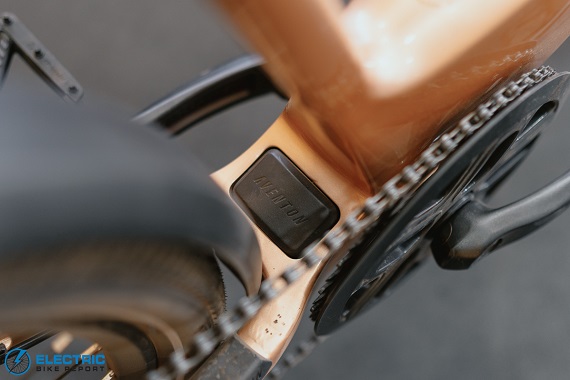
The ACU module is set into the rear triangle and includes a 4G chip for location tracking and more.
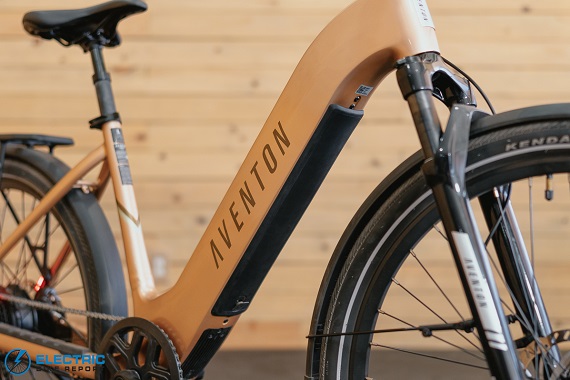
The Level 3 ST features a locking battery that ejects from its dock in the down tube.
Aventon Level 3 ST Review: Speed Test
To test the Level 3 ST’s speed and evaluate the programming and power distribution of its pedal assist system, I rode the bike on a flat section of a nearby paved, shared-use path. I pedaled the bike in each of its three assist levels with maximum speeds of both 20 mph and 28 mph to find my average speeds, and I also tested the bike’s throttle acceleration.
As shown by the graph above, the bike gave me nearly identical results in two of its three PAS levels in both of my pedal tests. These settings are not limited in speed, so in theory, I could have reached either the 20 or 28 mph limits in Eco mode with enough pressure on the pedals. As you might expect, the higher settings simply make the task easier.
Eco mode felt natural, delivering a helpful but reserved amount of power, which I consider appropriate for a power-saving setting. In contrast, pedaling in Turbo mode was extremely easy and fast thanks to its plentiful power output. Sport mode seemed to split the difference, leaning more toward Turbo than Eco, at least with the bike’s standard settings.
As hinted at in the introduction, users can customize the motor’s power output through the Ride Tune feature in the Aventon app. Three parameters can be altered using sliders: Torque, Assist, and Pedal Response. The first two adjust the amount of help the motor provides, while the third adjusts the sensitivity of the bike’s torque sensor.
My results in this test would likely have looked different if I’d made adjustments to the bike’s power output. They should be considered a guide, regardless of motor tuning, as this bike features a torque sensor that enables its motor output to match the rider’s pedaling. You and I likely pedal differently, so our speeds will naturally vary.
When testing the Level 3 ST’s throttle, it had no trouble reaching the 20 mph maximum speed. I liked that the bike picked up speed steadily without feeling like it was getting out of control. This makes it both practical for starting up and getting through an intersection or taking a break from pedaling, but also safe and approachable for newer riders.
All in all, the Level 3 ST performed extremely well in this test, showing that it can reach its advertised speeds easily with an intuitive distribution of power levels.
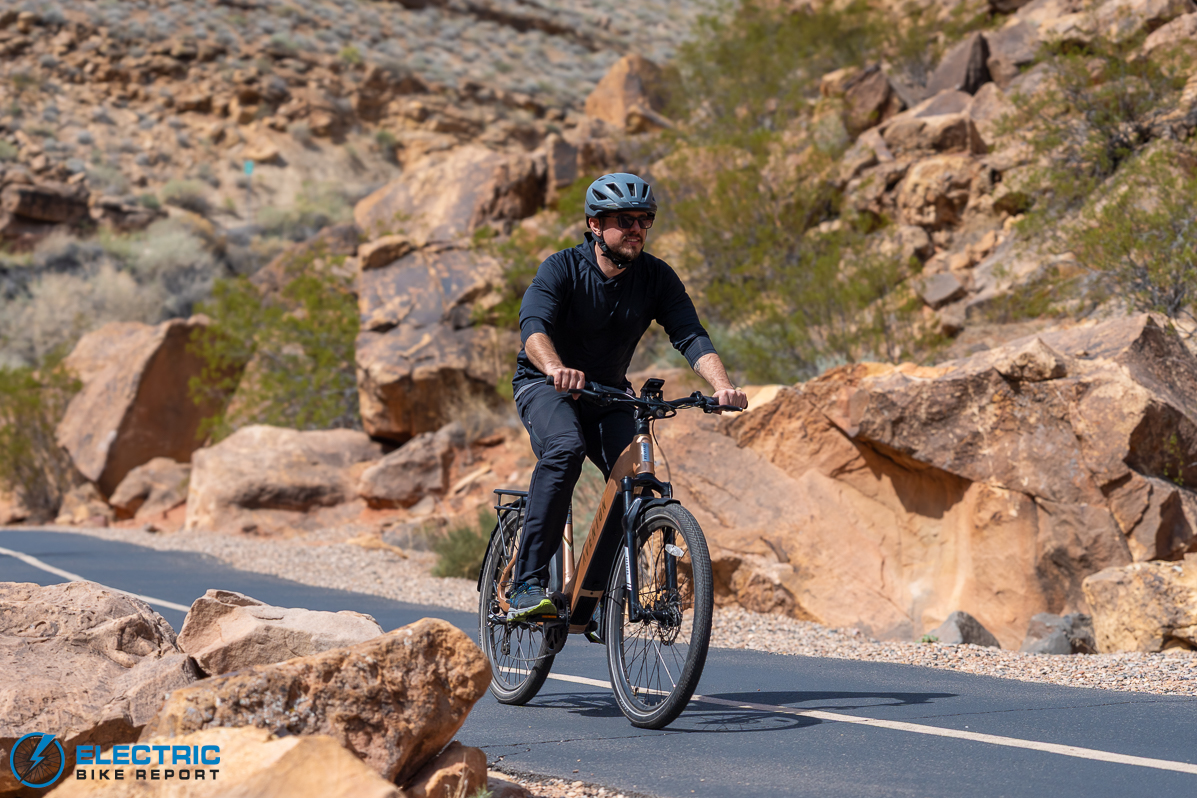
The bike’s riding position is appropriately sporty without feeling too aggressive; it’s a happy middle ground!
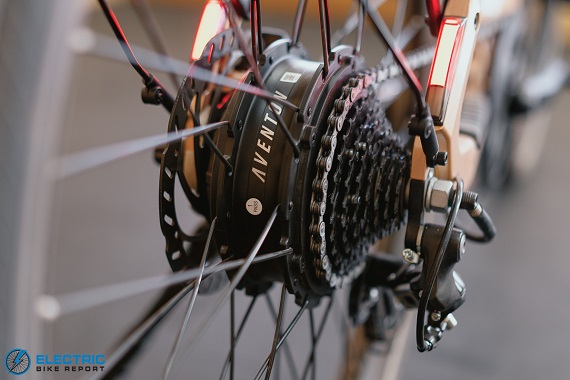
With a highly responsive torque sensor, the Level’s 500W motor delivers power quickly and adapts to how you pedal.

The 8-speed drivetrain is geared for efficient climbing and riding up to 28 mph when set to Class 3 speeds.
Aventon Level 3 ST Review: Range Test

The Level 3 ST’s results in our Range Test are shown in the graph above, along with an explanation of the method used to gather our data.
Our testers’ results of 44.2 and 80.6 miles are well above average when compared to other commuters we’ve tested with 500-watt hub motors. In fact, the Level 3’s mileage in both tests is among the longest distances we’ve traveled on a similarly specced e-bike! The models we used for comparison averaged 29.9 and 54.7 miles.
Battery capacity seemed to be the Level’s biggest advantage in this test; its 733-Wh battery has nearly 100 Wh more than average. Similar e-bikes we’ve tested had batteries with an average capacity of 638 Wh, so Aventon’s commuter had roughly 15% more power in reserve, allowing it to continue moving for longer distances.
Additionally, the Level’s torque sensor helped it stretch out its charge. E-bikes with this type of sensor tend to be more efficient than those with cadence sensors, as their motor output can fluctuate as needed instead of maintaining a constant flow.
During my time on the bike, I found myself riding in Eco and Sport modes more often than not; I only rarely needed the extra power of Turbo mode for pedaling up and over large hills. As such, I’d expect most riders who are comfortable with a moderate level of effort to get somewhere on the mid to high end of our results.
Most riders we’ve interacted with who commute to work daily travel less than 30 miles in a day. Those in a similar range should be able to get at least a few round trips out of the battery before needing to recharge, while commuters or leisure riders taking shorter trips may get a week or more out of the Level’s battery!
The Level 3’s performance in this test placed it among the best commuter e-bikes we’ve tested, earning it our emphatic approval. Its results proved it to be a great option for long and short-distance travel. We were also pleased to note that the bike includes a 4-amp fast charger, which can charge an empty battery to full capacity in about five hours.
Aventon Level 3 ST Review: Hill Test
For our Hill Test, the Level 3 ST’s results and our testing methods are again shown in the graphic above. When compared with similar commuter e-bikes we’ve reviewed, the Level’s performance was relatively average, proving it to be an effective climber.
The bikes used for comparison averaged 1:52 in their throttle test and 1:24 in the pedal test, making the Level 3 ST’s throttle two seconds slower and its pedal test time 3 seconds faster than average.
Motor torque is one of the primary factors in the pedal test, and the Level 3’s motor produces a maximum of 60 Newton meters of torque. The average torque among similar models used for comparison was 60.3 Newton meters, so the Level’s results make sense.
Based on our data, a bike’s results in the throttle test seem to rely more on the motor’s peak wattage. Brands do not often publish this piece of data, so we had a smaller pool of models to compare the Level 3 with; however, its peak of 864W was similarly close to the average. As such, its relatively average throttle test results also add up.
Once again, we tested the Level with its standard motor output settings, but the 90% default for the Assist power output parameter in the Ride Tune feature leaves some room for adjustment. When changed, this setting could potentially further improve its climbing performance.
Regardless, our testing showed that the Level’s motor is powerful enough to give riders the option to throttle or pedal over most hills. Those choosing to use a helping of leg power to aid the motor likely won’t end up wearing themselves out or getting too out of breath. And as a reminder, I found that Sport mode had enough “juice” for most hills I encountered.
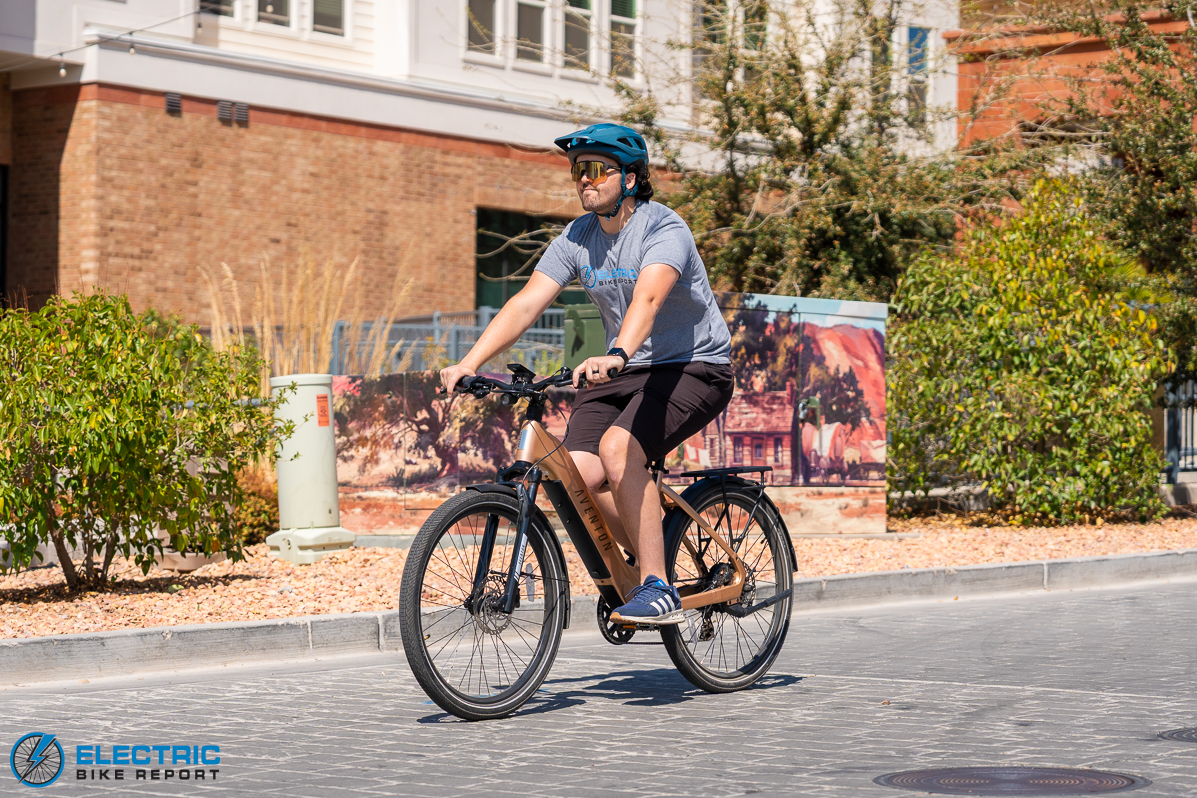
The Level 3 ST has a recommended height range of 4’11’ to 6’1” and a payload capacity of 300 lbs.

A thumb throttle is placed on the left handlebar next to the control panel with rubberized buttons.

The Magura AT-2 hydraulic brake system is powerful, though we wish its brake levers were less flexible.
Aventon Level 3 ST Review: Brake Test

The Level 3 is equipped with a hydraulic disc brake system with 2-piston calipers and 180mm front and rear rotors. This system, the AT-2 from Magura, proved to have powerful stopping ability; the Level’s result in our Brake Test (explained above) was an impressive 22’4”.
Commuter e-bikes with hydraulic brake systems have averaged an identical result of 22’4” while being notably lighter. At 72 lbs, the Level 3 ST is approximately 7.5 lbs heavier than the average commuter weight of 64.5 lbs, and therefore, more difficult to bring to a stop.
In my experience, the Magura brake system compensates well for this added weight; its braking force surprised me the first couple of times I squeezed the levers. I noticed that the levers had a fairly long pull before the calipers engaged, but there was decent modulation once I reached that point. I recommend that new riders practice to get a feel for how much pressure to apply.
The brake levers themselves are one of my few points of critique for this bike; they’re made of flexible plastic that did not feel remarkably durable. Due to their flexibility, they also often got close to pinching my fingers.
As our results show, this brake system performs well, so I believe Aventon made a good choice overall, but I encourage the brand to use sturdier alloy levers in the future.
Otherwise, I was pleased with the Level’s result in this test and its safe, stable feel when braking.
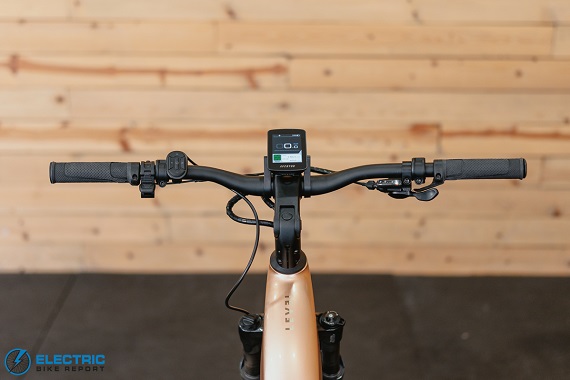
The 680mm handlebars encourage a forward-leaning riding position and offer good steering control and balance.
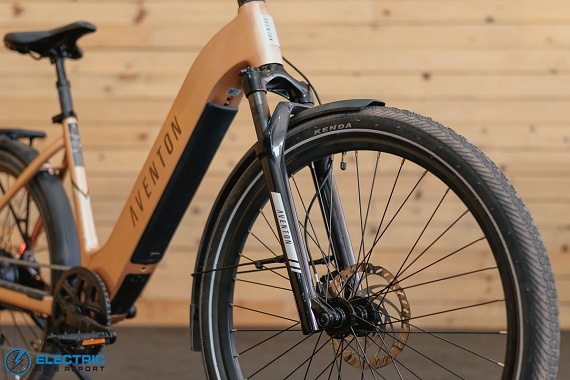
The suspension fork features 80mm of travel for smoothing rough pavement. It also has a lockout and preload adjustment.

The sport saddle is mounted to a suspension seatpost with 50mm of travel to keep your rear on cloud nine.

An adjustable stem allows riders to tailor the bike’s fit and riding position by adjusting handlebar height and reach.
Aventon Level 3 ST Review: Ride Quality
The subject of Ride Quality encompasses many smaller elements of a bike’s feel and function, including its sizing and fit, the responsiveness of its motor, the user-friendliness of its controls and interface, and so on. As we examine the Level 3 ST’s ride quality, I’ll break down each of these sections and add in details from my testing.
Starting with sizing and fit, the Level 3 has both a step-thru and high-step frame that come in two frame sizes. We reviewed the high-step model separately. The regular ST frame fits riders from 4’11” to 5’7” while the large size we tested accommodates those from 5’7” to 6’1”.
At 5’11”, near the top end of the large frame’s height range, I found a proper fit with full leg extension and a forward-leaning riding position that felt sporty but comfortable. The bike has two main points of adjustment: a seatpost with roughly 6” of adjustment in saddle height and an adjustable stem that allows users to change the handlebar height and reach.
I found the saddle supportive and firm without making me sore on long rides. The rubber grips were soft and textured, making them easy to hold on to.
In my experience, the bike’s handling was a great match for its stretched-out and sporty design. It felt stable and sturdy without feeling weighed down, so it maneuvered well and cornered crisply. As mentioned in the Speed Test section, the ride itself could feel reserved and natural or quick and peppy, depending on the pedal assist level; both sensations suited the bike’s style.
The ride was generally quite comfortable thanks to the bike’s suspension fork and suspension seatpost. The former offers a generous 80 mm of travel, while the latter offers 50 mm of movement to absorb bumps and vibrations. The bike’s 27.5×2.2” tires add more cushion while providing stability and traction.
I always appreciate an e-bike that includes safety features such as lights and turn signals, but in contrast to the previous version of the Level, the 3rd generation model does not include tail lights with brake light functionality. This is primarily due to the fact that its brakes do not include a motor cutoff function, which has a few tradeoffs.
On the positive side, the rider can apply the brakes and receive power from the motor simultaneously, resulting in a more natural experience. It also means that the bike is not limited to using e-bike-specific brake systems. On the other hand, I consider brake lights an essential feature on a bike meant to share the road with larger vehicles; we’d prefer to see Aventon bring them back in the future.
I liked the Level 3 ST’s user interface, which consists of a color display and a 5-button control panel with controls for the pedal assist system, lights, and turn signals. Users can set up a passcode using these buttons, which I highly encourage, considering that the wheel lock and battery lock can be governed through the display as well as the Aventon app.
I’ve mentioned the Ride Tune feature of the Aventon app, but it has many more elements to mention. The app can be used to track ride data and syncs cleanly with Apple Health and Strava. It gives users the ability to interact with other Aventon e-bike owners through a private social media platform. It can also activate and control the Level’s security features.
In addition to the motion detection/alarm system and remote disabling feature, the app can be used to set geofencing boundaries that limit where the bike can and cannot be ridden. We view this feature as ideal for parents who wish to limit where and how far their child can ride the bike; the PAS will be disabled when entering a restricted zone or crossing the boundary of an allowed zone.
Many of these features, including the ACU’s 4G chip, require that an annual subscription service be maintained. The service is priced reasonably at $20 per year or $2 per month.
I found the app well organized and highly functional, though there is a learning curve to get the most from its features. Those interested can see a walkthrough of the app in our video review linked near the top of this review.
These elements add up to excellence; the Level 3 ST’s ride quality is top-notch, thanks to its handling, responsive power output, overall comfort factor, accessible step-thru frame, and its integrated technology.
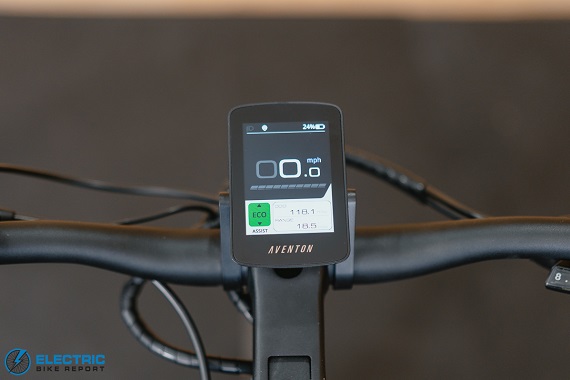
Aventon’s color display is well-organized and presents information clearly.
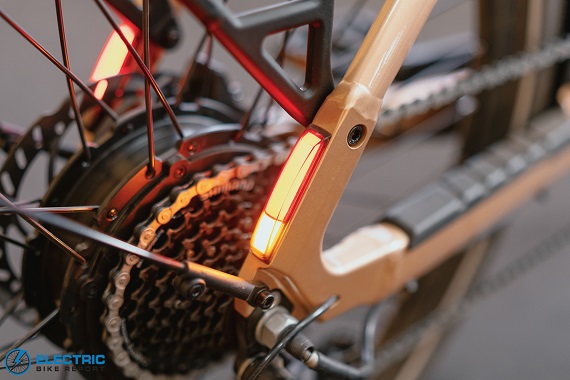
Tail lights and turn signals help out with visibility and communication on the road.
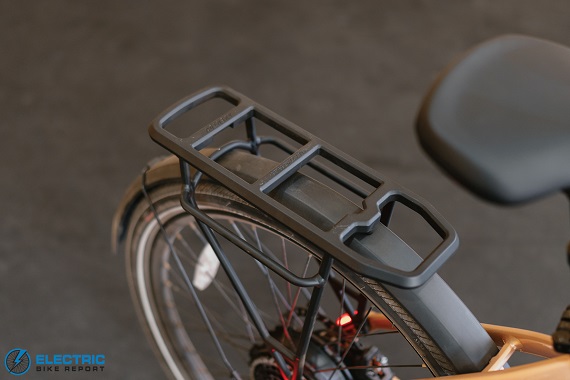
The Level 3 ST’s cargo rack has a 59.5-lb carrying capacity.
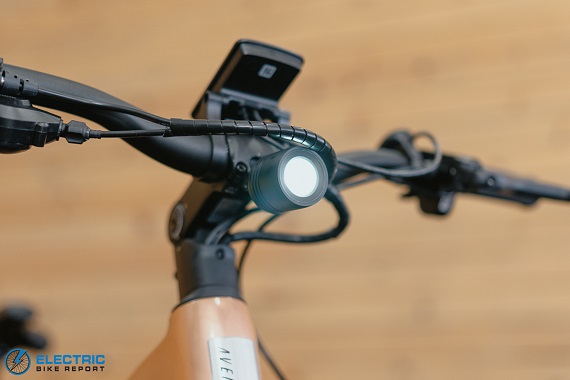
While small, the integrated LED headlight is nice and bright.
Aventon Level 3 ST Review: Summary / Where to Buy
The company’s last generation of bikes went all-in on combining rear hub motors with torque sensors. This combination was once a relatively rare thing, but Aventon largely paved the way for what is now a standard in the industry.
The ACU module found on the Level 3 is its next big leap forward, but I think this bike is a great example of the other, less obvious ways Aventon has evolved. Its design is sleek, its ride is precise and fun, its geometry feels spot-on, its PAS is intuitive, and its combination of security features and the app gives its user experience an extremely high-tech and connected feel.
Still, the bike isn’t perfect (though it is admittedly close). We’d like to see sturdier brake levers and functioning brake lights in the future, but otherwise, the Level 3 ST did a great job in our testing, with average to excellent results across the board.
Its standard programming has well-balanced power levels that can be refined to fit its rider’s preferences. The bike stops safely and effectively. Its peppy motor allows riders to pedal or throttle uphill confidently, and, perhaps most importantly for a commuter, it has the ability to cover multiple extended commutes on a single charge.
Based on my experience, I recommend the Level 3 ST to riders who want a bike that’s easy to get on and off, can go on long rides before needing to recharge, feels sporty, and rides a lot like an analog bike. Whether you’re looking for a cool bike to cruise around town on or a dedicated daily ride to work or school, this is one I highly recommend checking out!
Happy Riding! Make sure to let us know if you have any questions or if you think we left anything out in this review of the Aventon Level 3 ST down in our comments section.



Do you think Aventon meant to say the brakes are Magura MT A2? Those are their entry level brakes and the picture on Magura’s website matches the ones on the Level 3. From some research it doesn’t appear Magura makes brakes called AT-2. Also any thoughts on Aventon subbing in Tektro brakes with motor cutoff after some complaints? There’s quite an uproar about this on the Aventon sub-Reddit.
Hill test is only 12%? Need 25%.
Only the first batch of Level 3s come with the Magura brakes tested here. All subsequent batches come with Tektro brakes that include a brake cutoff sensor and brake lights. You can see two different sets of brakes listed on Aventon’s Level 3 page, and their official Reddit account talks about it. Any chance you all could test a Level 3 with the tektro brakes to see how they compare?